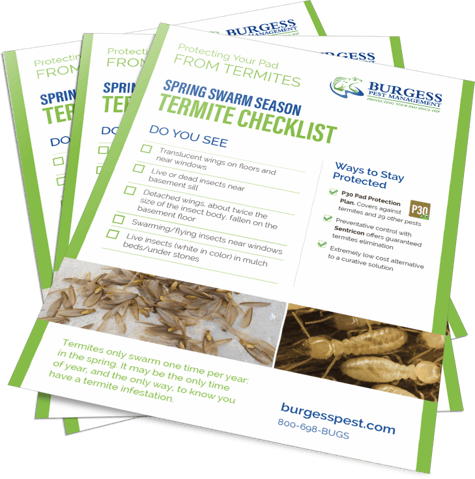508-587-4309 | Customer Login
Protecting Your Pad from Termites
It may be the only time of year, and the only way, to know you have a termite infestation.
Download our FREE Termite Check List for the Spring Swarm Season
Termite FAQ’s
Top Questions About Termites
What does a termite look like?

Termite swarmers, winged termites (pictured above on the left), have bodies about ¼ of an inch long and two pairs of wings the same size and shape. Winged ants have two sets of wings that differ in size and shape.
Termite workers (pictured above on the right) are soft-bodied, pale, about ¼ of an inch long, or less. While ants have three distinct body sections and a “pinched waist”, termites usually appear to have a head and body region. Antennae are straight.
Do termites live in the home? Where do they come from?
The most common termite in the US is the subterranean termite, which live in colonies underground and can also be found in moist areas above ground. If you have a termite infestation in your home, they may leave signs such as mud tubing. It is possible that termites may be consuming wood along your basement sill, as well as other interior and/ or inaccessible areas.
Why might my home be attractive to termites?
Termites are attracted to wood and cellulose materials; warm, dark places; and moist soil. Avoid storing decaying lumber or firewood, or cellulose materials such as newspaper or cardboard near the foundation of your home. Reduce moisture in your crawl spaces as well as the soil around your foundation to help keep termites at bay.
What kind of damage can they cause? How can I tell if it’s termite damage or rotting wood?
The National Pest Management Association has estimated that treating for and repairing damage done by termites in the U.S. can exceed $5 billion dollars annually.
Subterranean termite colonies can consume an impressive amount of wood—a colony of 1 million members can consume approximately 15 pounds of wood per week. This can damage insulation, piping, support beams, foundations, and even furniture. Taking action against these pests immediately can save a homeowner some very costly repairs.
Consulting a pest management professional is the best way to find and correct potential risks.
When do termites swarm?
For many homeowners, swarming termites might be the first sign of an infestation. Swarming varies by subgroup. Subterranean termites swarm typically in spring and during daylight. Ideal conditions include recent rainfall, overcast weather, and low winds.
How can termites be controlled or treated?
Common options for termite treatment include conventional termiticides and Sentricon in-ground systems. It is recommended that homeowners consult with a pest control professional who can accurately assess the infestation and determine the appropriate course of action.
What are the benefits of each treatment over the alternative? How does the Sentricon system work?
These in-ground stations are placed around the perimeter of your home. Termites will come into contact with the material inside the stations, inadvertently consuming a growth inhibitor. They then return to the colony and share the “food” with other members, and as the growth inhibitor effects take hold, the termites are prevented from molting and thus, die off.

